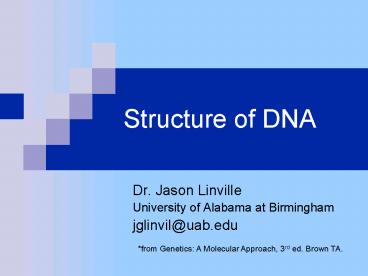Structure of DNA PowerPoint PPT Presentation
1 / 40
Title: Structure of DNA
1
Structure of DNA
- Dr. Jason Linville
- University of Alabama at Birmingham
- jglinvil_at_uab.edu
from Genetics A Molecular Approach, 3rd ed.
Brown TA.
2
Summary
- DNA is a polymeric molecule composed of
nucleotides
- Proving the double helix
3
DNA is polymeric
- DNA is a polymer
- Monomer units are nucleotides
What is a nucleotide?
Adenine Cytosine Guanine Thymine
Phosphate Group
Base
Deoxyribose sugar
4
DNA is polymeric
- DNA deoxyribonucleic acid
- Monomer units are nucleotides
What is a nucleotide?
Adenine Cytosine Guanine Thymine
Phosphate Group
Base
Deoxyribose sugar
5
DNA is polymeric
Adenine Cytosine Guanine Thymine
Phosphate Group
Base
Deoxyribose sugar
Carbons are numbered 1 (1 prime) to 5 (5 prime)
6
DNA is polymeric
7
DNA is polymeric
Adenine Cytosine Guanine Thymine
Phosphate Group
Base
Deoxyribose sugar
8
The 4 Nitrogenous Bases
A Adenine
C Cytosine
T Thymine
G Guanine
9
The 4 Nitrogenous Bases
A
C
T
G
10
The 4 Nitrogenous Bases
A and G Purines Double Rings
A Adenine
G Guanine
11
The 4 Nitrogenous Bases
C and T Pyrimidines Single Rings
C Cytosine
T Thymine
12
DNA is polymeric
Adenine Cytosine Guanine Thymine
Phosphate Group
Base
Deoxyribose sugar
Phosphate group is the acid of the nucleic acid
13
DNA is polymeric
?
a
ß
dAMP
dATP
14
DNA is polymeric
- Polynucleotides composed of nucleotides
Normally built from nucleoside triphosphate
subunits (dATP, dCTP, dGTP, dTTP)
15
DNA is polymeric
Normally built from nucleoside triphosphate
subunits (dATP, dCTP, dGTP, dTTP)
- a phosphate attacks the 3 carbon of next
nucleotide
16
DNA is polymeric
- Forms phosphodiester bonds between nucleotides
- Phospho P diester 2 ester bonds
- ß ? phosphates and 3 hydroxyl are lost
17
DNA is polymeric
5 end
- Polynucleotides have chemically distinct ends
3 end
18
DNA is polymeric
- Polynucleotides can be any length and have any
sequence
- Several thousand basepairs length in lab
- Millions in chromosomes
- No chemical restrictions on how they join
- 10 in length 410 1,048,576 sequences
- Variability enables genetic material to exist in
an infinite number of forms
19
DNA is polymeric
- RNA is also a polynucleotide
- Two differences
- Ribose instead of deoxyribose sugar
Deoxyribose
20
DNA is polymeric
- RNA is also a polynucleotide
- Two main differences
- Ribose instead of deoxyribose sugar
- Uracil instead of Thymine
21
DNA is polymeric
- RNA is also a polynucleotide
- Another important difference
- RNA occurs as single polynucleotide
- DNA occurs as two polynucleotides wrapped around
each other in a double helix
22
Summary
- DNA is a polymeric molecule composed of
nucleotides
- Proving the double helix
23
Proving DNA is double helix
- 1950s Structure of polynucleotide known
- 3-D structure of DNA not known
- Single Polynucleotide ?
- Double Polynucleotide ?
- Triple Polynucleotide ?
- K-Fed Polynucleotide ?
24
Proving DNA is double helix
- All Watson and Crick did was build a model.
- Based it on 2 key experiments
- Chargaffs base ratios
- X-ray diffraction experiments
25
Chargaff
- Erwin Chargaff
- Critical of Watson and Crick and scientists in
general. - Nature 326199-200, 1987. Engineering a
molecular nightmare.
26
Chargaff
- Used paper chromatography to determine relative
amounts of each base.
27
Chargaff
- Procedure
- Break molecule into mononucleotide components
using acid or alkali - Paper chromotography with n-butanol as the
mobile phase - Resulting spots were cut out and dissolved in
aqueous solution - Concentrations were measured
28
Chargaff
- Results
- Conc. A approximated Conc. T
- Conc. G approximated Conc. C
- GC content varied considerably depending on
organism
Chargaff didnt speculate on pairing.
29
Chargaff
30
X-Ray Diffraction
- Rosalind Franklin and Maurice Wilkins
- Took photos of X-ray diffraction patterns of DNA
- Didnt get along
31
X-Ray Diffraction
32
X-Ray Diffraction
- Crystal is bombarded with x-rays
- Angles the x-rays pass through are determined by
the structure of the molecule in the crystal. - X-ray beam exposes film after passing through the
crystal
33
X-Ray Diffraction
- Wilkins and Franklin used x-ray diffraction
technique on purified DNA
34
X-Ray Diffraction
- Showed a helix with 2 periodicies of 3.4 angstrom
and 34 angstroms along the axis.
35
Watson and Crick
36
Watson and Crick
- After earlier models proved impossible, finally
settled on double helix. - Based on Chargaffs ratios and X-ray diffraction
37
Watson and Crick
- Features
- 2 polynucleotides
- Nitrogenous bases on the inside
- Bases interact through hydrogen bonding
- Anti-parallel double helix
- Right handed helix
- Base pairs perpendicular to the helix
38
What is DNA?
- What does DNA look like?
Sugar Phosphate Backbone (Sides of Ladder)
Nitrogenous Base (Rungs of Ladder)
39
The 4 Bases
The bases pair up to form the rungs of the ladder.
A pairs with T
G pairs with C
40
Watson and Crick
GC
AT

